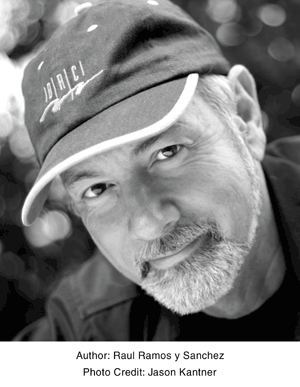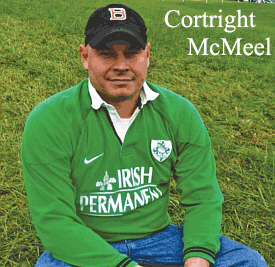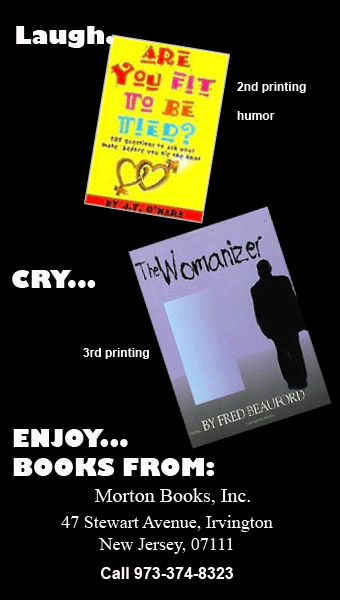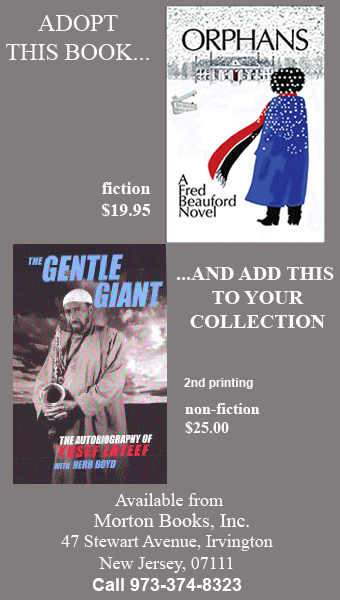REVIEWING
The No Luck Club
Getting to Happy
by Terry McMillan
Viking | 400 pages | $27.95
Reviewed by Loretta H. Campbell

A crazy black woman shouted on a Brooklyn bus one day, "(Black) men lie!" This seems to be the opening theme in Terry McMillan's Getting to Happy, a variation on the romance genre made popular in her previous narratives, Waiting to Exhale and How Stella Got Her Groove Back. This novel is a follow-up on four Black middle-aged women, Gloria, Robin, Savannah, and Bernadine, from these previous books. Here they reconstruct their lives after various kinds of trauma, beginning with their troubled relationships with spouses, ex-spouses, midlife crises, and drug addiction.
The worst of these problems happens, in the case of Gloria, not because of her husband, Marvin, but to him. While running an errand, he becomes the victim of a drive-by shooting. Even in upscale Phoenix, Arizona, where these women live, Black people suffer from gang violence. His death echoes the kind of headlines read every day in some parts of the country.
Yet, it begs a question. Why is the only decent black man in the novel the one who dies a horrible death? Here we come to the theme in the aforementioned books and many of those in this genre. That is, decent Black men are an endangered species, especially because of the homicidal tendencies of their brothers. Even more disturbing: do black male criminals get away with killing decent black men? In this book, they do. When the police officers inform Gloria's son, himself a detective, of what has happened, he asks. "Do you have anybody in custody?"
"Not yet. When we got to the scene, they were of course, already gone. You know they do this shit, man."
This particular tragedy could be a book in itself. In it, McMillan presents what could have been a powerful symbol of loss. Just before hearing the news, Gloria drops a cartoon holding 18 eggs. Marvin's death comes on the eve of their 14th wedding anniversary. If the reader expects an in-depth look at harrowing grief, presaged by this image, they will find that is not what is offered. Instead, McMillan gives short shrift to the pain of this character.
True, we see that Gloria binges on food. She (Gloria) says her friends comfort her during crying jags, and she takes a chance on a business venture. Yet, these are examples of the success of having coped with help of her support system. What about the details of the day-to-day survival through wounding grief? As shown in this book, the grieving seems all too brief.
Meanwhile, Gloria's three friends are dealing with pain of a different kind from their menfolk. Their spouses and former spouses are, in one case, a bigamist, in another, a porn addict, and in a third, a lazy loser. Once again, we see that Black men are under threat, but not just from each other. Because in this novel, they lack morality and ethics, and they have no life force to sustain them--except from their spouses.
Said spouses have sacrificed financial security, and in one case, health, for these men. Why? As outlined in this book, Black women should expect to suffer at the hands of Black men. Our men are a danger to themselves and us, but they're all we've got or deserve. Interestingly, two of the men in the novel change their ways and seek to either apologize or make amends to their wronged former wives. However, the men do so after having been wronged themselves or imprisoned. The women in this book lament a great deal about the same thing, but seem to learn nothing. Neither does the reader.
That's because the book lacks clarity. First, it is difficult to distinguish one woman from another. The speech and tone are almost identical for all four of them.
When Savannah finds out her husband is a porn addict, she calls her sister for comfort.
"No, I just found out Isaac's been visiting a bunch of porn sites for the longest and I'm a little pissed off."
"I hope this isn't all you're tripping about?"
"If you saw the shit he's been doing and how much money he's been spending. I think you'd been a little pissed too."
"Girl all men spend money on porn sites. I'm grateful for 'em, if you want to know the truth. Saves me a lot of unnecessary energy."
Or, in another example, Robin is advising Bernadine on her (Bernadine's) upcoming blind date.
"Just remember you're not auditioning to be a Vegas dancer, so tone it down for everybody's sake. Call me if anything changes. Bye. And good luck. I swear to God, what some of us will do to get laid."
So much for the comfort of sisterhood. Although in fairness, the friends are nicer to each other in various parts of the book. Still, it's equally difficult to tell the children of these women apart, except for one in particular.
Diamond, Gloria's granddaughter, doesn't speak. We find out it's because she is being abused by her mother. The child hasn't spoken for years, and nobody has figured out why. This is so incongruous that it screams. These characters are all professional women, but none of them ask the obvious questions about why this child is not verbal. This bombshell comes toward the end of the book. Once again, it is a topic that could be a book in itself. Yet, it is blown past.
The second reason the book and its purpose are unclear is its scary humor. When one of the young women totals her mother's car, her mother laughs hysterically. Initially, this would seem to be from a sense of relief. Her daughter is unhurt, and the car is replaceable. However, the daughter has taken the driver's test numerous times and failed because she never studied for it. Are there mothers, even in novels, who would allow their children to take a driver's test without studying for it? Would they allow their kids to drive? If anything, the problems that these two children have speak to a level of dysfunctionality in both the mothers and their children.
Another troubling problem is that of Bernadine's addiction to pills. She develops the habit after learning that her second husband is a bigamist and has ruined her financially. She gets into a treatment facility and seems to be fully recovered very quickly---too quickly. Once again, there is more emphasis on the solution than the process.
However, this book presents a bigger issue for the characters, the readers, and this genre. That is, an unwillingness to identify abnormal and almost pathological behavior.
Black men who are bigamists, or porn addicts, or abusive in any way are not normal or the norm. That distinction is never really made in this book, or in this genre.
Towards the end of the book, McMillan introduces disturbing and disturbed women characters. Perhaps this is a way of looking at both genders. Still, this inability to deliver the characters' voices and personalities, a definition of issues, and even humor that is relevant to the story, is perplexing.
Not only were these issues for this book, but they are issues for other books in this genre. Craft is lacking. Whatever the formula for a genre, the reader has to be able to follow the story. Equally important, serious problems can't be introduced and abandoned without explanation if the reader is to respect the work.
A crazy woman thinks that all Black men lie. The rest of us know that some Black
men, do.
Loretta H. Campbell is a writer, teacher and activist with the New York office of the National Writer's Union.
REVIEWING
House Divided
by Raul Ramos y Sanchez
Grand Central Publishing | 320 pages | $13.95
Reviewed by Michael Carey

There are growing debates over immigration and reform pushing its way up Capitol Hill. Fear and an atmosphere of terror still linger over the U.S. since the 9/11 attacks. The combination of these issues has great potential for disastrous circumstances. As questionable legislature like the Arizona law known as SB1070 (which has opened the door to racial profiling) pass, the near future has many bleak possibilities.
A future in which the passing of more oppressive laws and growing violence has led to Hispanics being deemed second rate citizens, to be separated from the rest of the of the nation, is the setting for Raul Ramos y Sanchez’s new novel, House Divided. This is the second episode in a planned trilogy that began with the award winning America Libre, and picks up where it left off. American Libre, Spanish for ‘Free America,’ takes place in the second decade of the 21st century. Violence and fear, rising in the Hispanic communities around the U.S., have escalated and garnered attention in the global spotlight.
The first book introduces some of the main characters, including the protagonist, Manolo ‘Mano’ Suarez, an ex-Army Ranger, torn between his people and his country. The growing troubles and unrest set the stage for an oppressive legislation, the construction of Quarantine Zones to house the newly created ‘Class H’ citizens, the rise of a Hispanic liberation movement and the Marcha Offensive that occurs the day before House Divided begins.
There we find Mano Suarez, struggling to find the salvation of the Hispanic Republic of North America’s cause after losing much of their resources in an attack on strategic U.S. targets. He has been reunited with the remainder of his family, his wife, Rosa, and their son, Pedro. Suarez struggles to keep them safe and together while advancing the cause of their people. He finds that there is a time to fight, and a time to regain strength and plan, even though these notions seem contrary to their culture of courage and ‘cojones’.
As the leaders of both sides play a chess game of politics, public opinion, terror, media coverage and action, we get to know many characters who line up to play their parts. Some are worthy of admiration despite their ties, ethnic origins, resolve, or actions, while others seem despicable from the start. The leaders of the HRNA have lost communications following the Marcha Offensive, leaving Mano the task of helping his people become self-sufficient, and focusing on strengthening their cause during the U.S. government’s crack-down on the Quarantine Zones.
However, a terrorist faction emerges, trigger-happy, and convinced that the Hispanic desire to fight will decrease with time. They try to rouse the U.S. into mistreating their people and to binding the inhabitants of the Quarantine Zones together, thereby driving them to strike back. Pedro, disgusted by his father’s refusal to fight, joins the terrorists. His eyes are opened as he tries to discern what is right and fights to overcome his own anger, pride, and preconceived notions of courage and what makes a man. Pedro’s new friends land him in a hairy situation and we ultimately question whether Mano will be able to save his son and the future of his people.
The storyline carries us through this tragic future that oddly does not seem as far-fetched as when Sanchez started the series in 2004. The current political climate and many voices in America have made the setting of House Divided more imaginable. And who better to weave this stunning and enthralling tale than Ramos? He has an amazing story of his own that gives him personal experiences with insurgents and revolution. A son and kin to active supporters of Castro’s rise to power, the author of House Divided moved to New York City with his mother at the age of seven, but spent summers with his father in Cuba and received military weapons training at eleven years old. He has seen first hand “how some leaders use hate, fear, and patriotism for their own ends.”
No matter where the reader stands on immigration, Sanchez’s message of “the dangers of extremism – on both sides of this explosive issue” is especially imperative. Ramos warns, “the potential for a wide spread conflict lurks behind every escalation of our current war of words.”
His involvement in the Hispanic community, developing a documentary, Two Americas: The Legacy of our Hemisphere, and hosting MyImmigrationStory.com, an online forum for the U.S. immigrant community, is clearly an influence on his writing. He relays the diversity of the population called ‘Hispanic,’ comparing (through the insight of a character) the labeling of these people to “lumping everyone from a nation that speaks English into a single group.” Ramos points out the diverse and rich cultures of the ‘Hispanic’ population, but he also shows the similarities they share with all people and cultures, in family, friends, and the desire to live free.
I found House Divided easy to appreciate as a story of its own accord and I look forward to reading the conclusion of this riveting trilogy.
REVIEWING
By Nightfall
by Michael Cunningham
Farrar, Straus and Giroux | 238 pages | $25.00
Reviewed by Sally Cobau

Michael Cunningham's latest book, By Nightfall, is both earthy and metaphysical. It's also funny—very funny. Achieving all three—writing great sex scenes, then providing comic relief, while posing serious questions about mortality, seems a daunting task.Yet Cunningham writes effortlessly, building a complex, multi-layered structure where desire, grief, and reflection create an enormous friction. The book is very satisfying to read, as ripe and fruity as a good wine, as the sophisticated protagonist, Peter Harris, would jokingly say, for he is the hero of the novel.
Peter is the successful owner of an art gallery in New York City. He is also the husband of the beautiful, successful Rebecca, and father to Bea, erstwhile daughter who (much to her parents' consternation) has left college to become a bartender. There are good meals to consume and foreign movies (such as 8 ½) to watch. All is good in the world (besides the quiet tick of dissatisfaction about the daughter). But all of this is about to change. (Of course, the reader senses that beneath this life of outward physical comfort lies uncertainty, boredom, and restlessness.)
Enter stage left: Ethan Taylor, otherwise known as Mizzy, Rebecca's much younger—by twenty years—brother. Mizzy is unaccountably beautiful, rebellious, and flirtatious. He's been a druggie on and off for years, dabbling in heroin throughout his high school and college years, but he's also managed to be a glittering star, obliterating the dullness of those around him and drawing people to him like a prophet. He's also an aesthete, a man who doesn't seem to desire enough. He's come to his big sister straight from an unsuccessful "spiritual journey" to the Far East. It's a pattern he's repeated through the years, to come to big sis on the heels of disappointing love affairs (and there are many, with both men and women) and to dry out. This time he's going to try to "get it together" and do "something in the arts."
At first reluctant to have Mizzy, Peter soon becomes locked under his brother-in-law's mysterious spell—is the man/child still using? Will his beauty amount to anything? As a curator, Peter is consumed with the acquisition of beauty and the most enduring pieces of art. Ironically, he knows that he objectifies Mizzy, yet he's unable to stop himself. It doesn't help that Mizzy parades around the apartment naked. Peter soon finds out that Mizzy is indeed still buying drugs, but that only adds to the allure—Peter admits to himself that we have a hunger for destruction, especially the radical destruction of youth. Peter becomes voyeuristic, watching intently Mizzy's every move while drifting from Rebecca.
In one spellbinding scene, he pretends to sleep while Mizzy connects with a dealer and then indulges in the drugs he's procured. A thin wall separates the men, but Peter can hear every move the beautiful boy makes; it's as if they're irreversibly connected.
This book raises so many philosophical questions, especially about knowing the "other." Do we all experience life the same way or are we essentially different? How can we choose to be monogamous when there are so many others in the world? At one point in the story, Peter goes with an art collector friend to visit the Met. In one startling exhibition, a shark is housed inside a water and formaldehyde filled tank (a quick Google search confirms that this is a real exhibition, called "The Physical Impossibility of Death in the Mind of Someone Living," by Damien Hirst).
Observing the exhibition are some teens who are entranced by what they see, yet try to maintain their cool. There is one girl that Peter is especially taken with. Like Mizzy, she represents the fullness and possibility of youth. Peter realizes with a tinge of dismay that he will never know that girl, and that the connection he feels towards her (however precarious) will never be fully realized.
Perhaps we all have these highly personal, melodramatic moments of "recognition," our personal epiphanies, if you will. They can feel silly or irrelevant, yet they persist. They can consist of the elusive person you view in an airport or even the fleeting glimpse of someone in a moving car. Somehow you know—just know—that in another life…
One of these "moments" occurs for Peter when he brings Mizzy with him to deliver a four foot bronze urn to an art collector who lives in Greenwich, Connecticut. The scene is amazingly rendered—everything from the eccentric art collector (a woman named Carole Potter, who is described as a "pale, freckled, blinking woman who seems always to have something small and wonderful in her mouth, a round pebble from the Himalayas, a pearl, that makes it ever so slightly difficult for her to speak clearly…") to the bulky, rather jaded art handlers--seems perfect.
While there, Mizzy and Peter steal away to the beach and exchange a passionate kiss. For Peter, this kiss becomes symbolic for him, a taste of a world that he could easily fall in to and as he goes about his life, "post kiss," this memory expands exponentially in his mind, teasing him with the possibility that he is gay.
As I mentioned earlier, there is a lot of humor in this book. Peter often undercuts his lofty musings by funny asides. When he's having sex, he says he's not exactly a porn star and about being gay he thinks: "Accept that, like many men, you have a streak of the homoerotic in you. Why would you, why would anyone want to be that straight?"
The parts of this book that deal with the New York art world are most enjoyable, including the daily work of a curator. Cunningham deliciously describes the art world and artwork—some of it facile and childish, some of it urbane and reckless. He's looking for that one genius, a piece of art that will have lasting value, but has to deal with lots of trivial annoyances, such as the personalities of the artists, to get there.
Peter goes to visit the "urn" creator, Groff, in his studio, depicting Groff as a sort of child/demi-God, a somewhat spoiled, but not completely egotistical artist. The many strands in this book depict how we deal with friends, work, lovers, acquaintances, and children. There is also the question of family and how Peter comes to terms with the death of his brother, Matthew, of AIDS.
At one point, Peter, the insomniac, looks out his window and sees another night wanderer by the light of the window. Strangely, he has never seen the older man before. It's as if Peter views the man he is to become. The recognition is startling and speaks of the ghosts that haunt us in our world: "…it's as if Peter isn't here at all, and it occurs to him (is this the pill taking effect already?) that he may in fact be invisible, that he may be his own ghost, dead in his sleep, risen invisibly to watch himself at seventy-plus….Maybe the dead don't understand they're dead…"
How can we exist, knowing the inevitable…possibly by love? Cunningham probes this question and more in this exquisite novel.
Sally Cobau is a writer and teacher living in Lincoln, Nebraska.
REVIEWING
Love Conquers Naught?
Tiger Hills
by Sarita Mandanna
Grand Central Publishing | 2011 | 464 pages
Reviewed by Janet Garber

For a romantic saga of colonial India, with its lush background sets, fragrant coffee plantations, and titillating jungle soundtrack, Tiger Hills has some unexpectedly bitter lessons to impart about the power of Love and stars the stunning Devi and the virile tiger-killing macho man, Machu,. Love, actually, is rather destructive: it wants what it wants; it thinks it excuses everything one does in its name. And what is its exact relation to real life, anyway?
Tiger Hills explores this conundrum. This surprisingly cynical theme catapults a sweet tale of lifelong love, both requited and not, past some melodramatic plot twists, quasi bodice-ripping scenes and credibility-straining moments, into a novel worth its weight in coffee beans, one that could give Dallas (TV miniseries from the 70’s – 90’s) a run for its money.
Devi and Devanna, as their names suggest, are like two sides of a coin, growing up together in Coorg, Southern India, at the end of the nineteenth century. Devi is the first girl born to her family in 60 years. Her doting grandmother rubs flowers steeped in coconut oil into her hair, intoning, “You are my precious flower bud, my sun and my moon, along with all the stars in the sky.”
So, instead of getting a realistic vision of her place in the world, Devi follows her impulses and expects the world to play catch up. Her father, mother, and the villagers overlook her many missteps and breaches of convention.
Devanna is a motherless child a few years younger than Devi that she takes under her wing. He’s her opposite in most ways: contemplative, a shy boy, and so good with his studies that he’s thought to have “gold for brains.” As children and young adults, they are inseparable until Devi spots Machu at a fair and decides that he is to be her fate. And so we have the classic triangle in place.
Tragedy ensues (suicides, war, sickness, penury) and carries forth into the next generation. One can’t help feeling that Devi has no compassion for her steadfast friend, her own son, or other innocent bystanders, particularly the wife of Machu. How did she evolve from a softhearted girl who was despondent over the massacre of some chicks in the henhouse, and from the protective girl who crawled into the closet with Devanna to comfort him when he was frightened at his mother’s funeral, to someone so grasping and narcissistic?
As an adult, she overlooks the fact that other people around her are living their lives and trying to fulfill their own destinies; she shows no forgiveness towards others, and plunges ahead single-mindedly, keeping her own counsel. She’s forced to wear the pants in her relationship with Machu (or chooses to). Brooking no interference, she overcomes any obstacles put in her path, and creates a wildly successful coffee plantation, Tiger Hills. She buys several other plantations and becomes a rich landowner, quite a coup, then and now.
Devi forms a household made up of Devanna, her son, Nanju, and her adopted son, Appu (Machu’s son). She coddles Appu, raising him as she was raised, openly favoring him over her own flesh and blood. As can be expected, Appu grows up self-indulgent, lacking in ambition, and a product of British schools in India where he picks up some not-so-savory habits. He, too, has a kind heart underneath his bluster and is very fond of his “brother,” Nanju. Seemingly directionless, by the end of the story, he starts to show an interest in a political career – and he’s probably the perfect fit for politics.
All of the characters are artfully drawn and tug on our heartstrings despite, or because of, their frailties. Devanna, as a child, is taken under the wing of a German reverend who runs the mission school. The reverend prepares him for a medical or scientific career, but it all comes to naught, partially because of Devanna’s weakness of character and his inability to stand up to the bully at medical school, with no Devi around to back him up. The reverend does manage to awaken a passion for botany in his young student, and this knowledge is later key to saving the coffee plantation from a plague of insects. But a pivotal point in the plot requires us to accept that mild-mannered Devanna could also be capable of great brutality – I, for one, wasn’t buying it.
In the third generation, we are given a love affair that culminates in marriage: Appu marries Devi’s beautiful niece, Baby. Are they happy? No, because they now come from two different worlds – she wants to be a good Indian wife, but he’s become a Brit wannabe, hanging out in clubs, drinking cocktails and engaging in clandestine trysts with officers’ wives. They fail to produce an heir – she loses child after child in miscarriage – and their future as a couple looks bleak. We have to wonder if the grand passion between Devi and Machu would have survived the mundane realities of marriage.
As the story draws to a close in 1938, there’s a last surprising plot twist, the welcome resurrection of a character, steadfast and loyal in his devotion to the land and the family. As he rushes back to Tiger Hills, India takes her first steps towards independence from Britain (not attained until 1947), and Devi finally stops mourning what-might-have-been and reaches out to embrace her life.
Mandanna, in this first novel, gives us the Indian version of a saga of the Old South, replete with colorful descriptions of the land, insight into her characters’ attachment to family, tradition and history and their struggle to adapt to changing times. The book is dedicated to her grandparents, and it is likely that research into ancestral roots provided the inspiration for this exotic tale. May we hope for more from this talented new-comer.
REVIEWING
Short
by Cortright McMeel
Thomas Dunne Books; St. Martin's Press | December, 2010 | $24.95
Reviewed by Jill Noel Shreve

Gallagher, whose broad forehead and round, cherubic face made him resemble an overgrown toddler, sat at his desk, sipping a carton of chocolate milk. Andrews looked at his newest acquisition and furrowed his brow. Traders drank coffee, black.” In the opening scene of Cortright McMeel’s first novel, Short, McMeel introduces his audience to several high-powered energy traders at Allied Power, in Boston, including Gallagher, and Andrews. McMeel gives his audience an upfront, first-hand account of the trading floor—the comings and goings of cash, the ruthless behavior of employees, and the artistic strategies these traders must employ.
This novel, set in 2005, traces the lives of traders, brokers and executives—all folks who could use a pile of hundred dollar bills for kindling. McMeel focuses the novel on Gallagher, a new trader, Andrews, a veteran trader, and Jennings, the new head trader—a man everyone refers to as “The Ghost.” As the story unfolds, McMeel turns his audience’s attention to a huge deal coming down the pike and the dilemma Gallagher faces as he understands what’s at stake. He’s faced with the decision of falling in step with the other traders—the ones following The Ghost—or making a different choice, based on his mentor, Andrews’ encouragement. This alone has the tension to keep a reader flipping pages, but McMeel doesn’t stop there. He complicates the story by allowing several subplots to surface throughout the narrative. This technique, in turn, lures the reader in further, causing McMeel’s audience to emotionally invest in the characters on the page.
This is one of McMeel’s strong suits: how he makes these characters come alive. With dialogue and action, his audience will clearly understand the desires and aspirations of all characters involved, along with dialectics that exist in each relationship. McMeel sculpts and rounds out each character with precision and attention. The characters are likeable, even the villains. The only thing I wanted a little less of was the characterization of Daniel Haupt, a trader referred to as “The Colonel” in the novel. It’s clear from the onslaught that The Colonel’s fiendish. McMeel exploits this with dexterity. However, I felt like he pushed the envelope a little far with the use of a sensational sex scene to characterize him. We knew, by that point in the novel that The Colonel only cares about himself, so the scene seemed redundant. Had McMeel chose to leave the scene out, the character would have come off just as selfish—maybe even more so.
Because of the complexities that come with the trading industry, this novel has the potential of scaring off a lot of readers. If a reader’s never participated in the world of markets, brokers and trading, the reader may feel ostracized by the seemingly elaborate infrastructure. But McMeel makes the industry accessible to his audience through his concern for syntax and linear, forthright explanations.
And the reader won’t get bogged down in these explanations because McMeel reveals these inner-workings with patience and subtly. He peels back the wall of the trading floor without making a peep, allowing the characters to speak and act out this process of trading. McMeel makes the trading-game clear, articulating the risks and benefits. The reader will understand that the people involved in this game can lose or gain tens of millions of dollars in a single day and more specifically how this gain/loss cycle occurs. And this serves as an enticing backdrop for the novel, creating tension and causing readers to keep asking, “And then what happens?”
Against this elaborate backdrop, you’ll notice McMeel tackles several issues: loyalty to one side or the other, a need to be recognized, a desire for security. But one of the most interesting parts of the novel is how McMeel underscores the human condition of greed. This issue of the desperate need to have everything. And not only to have everything, but to consume everything in its entirety. McMeel shows us how all the characters in the novel consume something: money, alcohol, food, women, men, knowledge.
In tandem with this, McMeel illustrates the consequences of that greed, namely that one cannot have what s/he wants without sacrifice. In order for the people in the novel to get what they want, they have to sacrifice something: their dignity, honesty, respect, relationships, appearance, and reputation. Through the subtext of the plot McMeel does an incredible job of exploiting this human condition of greed and how that requires sacrifice.
Because of the characters, because of the plot line, because of the overall message of the book, I recommend this novel. When you finish the last page, you won’t just put the book on the shelf and stop thinking about it. You’ll ponder Gallagher’s choices. You’ll think about the outcome of Allied Power. You’ll wrinkle your nose and cock your head at the thought of men and women making (or losing) ten million dollars in a day. So, grab a copy in your local bookstore this December and find out whether Joe Gallagher and the rest of the high-powered energy traders get long or “Short.”
Jill Noel Shreve teaches Creative Writing at Hunter College in New York City. You can read more about her at www.jillnoelshreve.com.
REVIEWING
Ledgers of History: William Faulkner, an Almost Forgotten Friendship and an Antebellum Plantation Diary
by Sally Wolff
Louisiana State University Press | 2010 | 214 pages | $35.00
Reviewed by Sarah Vogelsong

As the pace of our culture has accelerated, our literature has become preoccupied with questions of where we are going and what we are becoming. But a road is two-edged, having not just a destination but also a point of origin. These origins and our inability to leave them behind are primary concerns of William Faulkner’s literature. In Ledgers of History: William Faulkner, an Almost Forgotten Friendship and an Antebellum Plantation Diary, scholar Sally Wolff, a professor of Southern Literature at Emory University, digs into Faulkner’s own past, uncovering a significant period for the author when his life intersected with that of an old southern family in the town of Holly Springs, Mississippi.
Wolff has a strong background in Faulknerian studies, but this book grew out of an unexpected incident. While arranging the annual English department trip to Oxford, Mississippi, Wolff received an email from an Emory alumnus that read, “I can’t go on the trip, but I knew William Faulkner.”
The author of the message was Dr. Edgar Wiggin Francisco III, whose father, Edgar Francisco, Jr., was a close friend and hunting buddy of Faulkner’s. This friendship persisted for thirty years, peaking in the 1930s, when the younger Francisco was a child. Most of Dr. Francisco’s memories of the relationship stem from the period between his fifth and ninth years, allowing him a unique perspective: rarely included in the two men’s conversation or activities, Dr. Francisco nevertheless had the privilege of observing their natural interactions. Indeed, reflecting on the memory of his father and Faulkner swapping stories on the porch of McCarroll Place—built in 1833 and kept in family hands ever since—Dr. Francisco commented, “This was my portal to manhood.”
Ledgers of History is divided into two parts: background and literary commentary, and the interviews Wolff conducted with Francisco. While the background Wolff provides in the first section is invaluable, her commentary is the weaker part of the manuscript when compared with the richness of the interviews, which compose the majority of the book. It is in these dialogues with Dr. Francisco, and through the sensitivity and intuition of her questions and the thoughtful insight into Faulkner, that provide that the greatest value of this work.
The introductory sections lay the groundwork for Wolff’s research by outlining the historical and genealogical background of the Francisco–McCarroll family and introducing the key record of this history: the Leak Diary, a plantation ledger kept by Francis Terry Leak, an ancestor of Dr. Francisco’s and a landowner living in Mississippi prior to the Civil War who kept detailed records of both his business and family affairs. Such a document is remarkable in and of itself, but it becomes even more so in light of its connection to Faulkner, who was “enthralled” by and “pored” over it. Dr. Francisco vividly remembers the author taking notes on the diary, recounting:
“I recall . . . an unusual aspect of [Faulkner’s] visits. A visit was in two separate parts. . . . The first part was his visit with Dad. . . . Then Will would pull out notes and ask for a particular volume of the diary and turn to the page he wanted. Then he seemed to totally change. He became sober, focused, sometimes agitated and angry, and talked to the writer of the diary . . .”
As both Wolff and Francisco note, the diary unashamedly reports not only those aspects of the South that made the culture great, but also those that made it reprehensible, with slavery being the perpetual shadow on its pages. Francisco’s memories of the effect of the Leak Diary on Faulkner provide a unique firsthand picture of the author in violent conflict with his heritage and identity. From a literary perspective, these memories allow scholars to better understand the origins his writing and help unlock the more difficult passages. In this sense, although Wolff’s opening commentary tracing the ways that the Leak Diary may have influenced Faulkner’s works—particularly Go Down, Moses—may be clumsy, it provides a foundation for later, more nuanced scholarship, constituting a valuable resource. On a less academic level, the Francisco interviews paint a keenly poignant portrait of Faulkner the man, whose pain countless generations of Southerners have identified with over the years.
It is difficult to refine out the key sections of the interviews because of their density, but one story does emerge as particularly significant: that of Ludie, a beautiful young ancestor of Dr. Francisco’s who lived in McCarroll Place during the Civil War; she used her diamond ring to carve her name into the glass of the window overlooking the gallery where the older Francisco and Faulkner would one day spend so many hours.
According to Dr. Francisco, this etching fascinated Faulkner, who incorporated the story into three different books. Francisco remembers that because Faulkner always sat on the porch, he always saw Ludie’s name from the opposite side. He refused to ever enter the room to read the inscription the right way around, saying,
“I feel as if she is standing in the middle of the room. . . . She’s right here. The past doesn’t die. . . . It’s right here. Ludie is right here. Nothing in this house has changed in a hundred years.”
As the interviews progress, they start to bear a curious resemblance to the conversations Dr. Francisco describes as having taken place between his father and Faulkner, in which they sat for hours, retelling the same stories and speculating over questions that would never be answered. Similarly, as the Wolff–Francisco interviews stretch on, the same stories reappear with different perspectives and emphases. The interviews themselves become an effective form of storytelling and by the close of the book, the McCarroll stories have become as rooted in the reader’s mind as his or her own family stories. To read these interviews is to catch a glimpse of the history that so overwhelmed Faulkner in his own time.
A story told by Dr. Francisco near the close of the book aptly illustrates the worth of this material. Describing a spring near McCarroll Place, Francisco notes that the native Indians kept the spring “cleaned out and silt-free.” Later, the settlers neglected the spring and the silt overwhelmed it, encroaching a few inches every year. It is hard not to draw a parallel between this story and the wealth dug out by Wolff in this book. A vast amount of information and insight has been neglected for years, but through Wolff’s persistent research and interviewing, a new source of Faulkner’s work has once again been unearthed and will be sure to have fruitful results.
Sarah Vogelsong is a journal editor and freelance writer living in Washington, DC.





